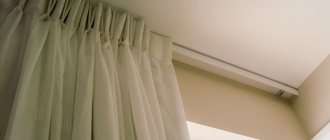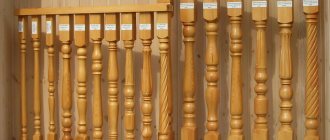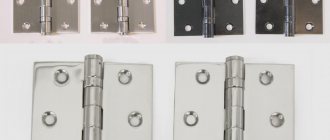Trench water convectors
The heating element is a hollow tube with welded or pressed metal plates. In them, heat transfer is carried out by a coolant (water or antifreeze, depending on the model). The devices are connected to the existing water heating system through threaded pipes. They are used in systems with forced circulation of coolant; the wiring is single-pipe or double-pipe.
For water convectors built into the floor, the materials from which the heat exchanger is made are important. Copper and copper-aluminum models (copper pipe, aluminum fins) can produce the highest power. There are also models made entirely of copper - both pipes and fins. But the price for them is considerable. More budget options use stainless steel, and even cheaper ones use galvanized steel.
The inside of the housing and heat exchangers are painted dark so they are not visible through the grille
Despite the greater power, installing devices with copper heat exchangers is far from the best choice. Copper is very capricious during operation, it requires a certain composition of the coolant, a grounding device, and is not compatible with all metals. All this together makes their operation in centralized heating systems problematic (although the technical characteristics allow this). It will perform well only in individual heating systems in which the heating distribution is made with copper, polymer or metal-polymer pipes. In this case, it is also advisable to have a copper heat exchanger for the heating boiler. Fittings and fittings should be installed in bronze or brass, as well as nickel-plated or chrome-plated.
Models and varieties
As in electric floor convectors, fans are installed in water convectors to increase power. This allows you to receive much more heat with the same dimensions of heating devices. The fans can be powered from a 220 V AC power supply or from a 12 V or 24 V DC source. To reduce noise levels, they are installed on vibration-proof supports.
Although forced convection units are noisier, they produce more heat. Therefore, they can effectively cut off cold flows coming from the glass. If you plan to use an in-floor convector as the main source of heat, it is better to install just such models - they heat the room faster and prevent condensation from forming on the glass.
There are models that can be used not only for heating, but also for cooling. Moreover, they come in two-pipe and four-pipe types. In four-pipe systems there are two separate heat exchangers connected to different systems - one for heating, the other for cooling. In two-pipe models, the same heat exchanger works with two systems. Four-pipe ones are more efficient, but also much more expensive.
Sometimes there are models that allow you to supply fresh air into the room - it is taken in through a special opening, cleaned in built-in filters, heated, and released into the room. A very useful function where there are double-glazed windows - it is the lack of oxygen and humidity that is a common problem in such rooms.
Upon request, built-in convectors can be made angular or with a radius of curvature - this is for rooms of non-standard geometry or for display cases. It is often possible to order a device of non-standard dimensions - specifically for your premises. Some manufacturers make special rotating heating elements - this makes it easier to clean inside the housing; some provide for installing a heat exchanger on flexible hoses - it can be removed and put away.
The inside of the housing and heat exchangers are painted dark so they are not visible through the grille
Separately, they produce devices for heating rooms with high humidity levels. They use materials that are resistant to such conditions and special electrical equipment. Also in such models there is a drainage drain to remove condensate.
Electromechanical or electronic thermostats control the temperature in the room and change the power of the convector. The devices themselves are located in the housing and controlled from a remote or remote control. Electronic models have the ability to program the temperature by time of day or day of the week.
How to choose
If you're unsure how to make the right choice, check out these tips:
- Decide whether a natural convention will be sufficient or whether it would be better to establish a forced one;
- If the house has a closed heating system, pay attention to the pressure in the pipes. If it may not be enough to warm such a large area. Data is usually requested from the Housing Office. And based on them, they choose a specific model for purchase;
- If the house is private, then the coolant can be anything. But in multi-storey buildings this is worth paying attention to. Residents of a private house can regulate the heat on their own, but in an apartment building this is not always possible.
- Therefore, you need to choose a model carefully, looking at its quality. Study the characteristics carefully so that there are no problems later;
- Before purchasing, find out which heating system you need to connect the radiator to. It can be either single-pipe or double-pipe. Some models will only work with one of the types.
- Also look at the connection diameter. If you have already purchased the device, but the diameters do not match, it’s okay. You can use an adapter;
If you are installing the device in a non-residential area, choose a model with condensate drainage. This will help maintain a favorable microclimate.
Advantages of floor-mounted convectors
Panoramic glazing and radiator
First of all, all the advantages of this type of heaters are associated with aesthetics and functional features. The most characteristic advantages are the following criteria:
- High heat transfer and performance. When using a water-filled heat exchange element, you can achieve an excellent balance in heat transfer and low financial cost of heating;
- Reliability, which consists of trouble-free operation and excellent resistance to aggressive water environments;
- Radiators are mounted in floors, and this opens up completely unique and interesting architectural possibilities. Batteries for more conservative use were placed on the walls under window openings. This limited the architecture of the windows, but if the heaters are located in the floors, then all restrictions are removed. It is possible to completely glaze the facade and create panoramic glazing, which is often used in greenhouses, private houses and rooms with shop windows.
Operating principle
The radiators built into the floor heat the room using the convective principle. They themselves are also convectors by design. This system heats the room more efficiently than any wall-mounted radiator model. The heated air rises to the ceiling, the cooled air remains below and is heated, i.e. active circulation and uniform heating of the room occurs. It maintains a constant temperature. Heating costs are reduced.
Choosing the optimal radiator. Video
A properly organized home heating system with your own hands using floor radiators primarily depends on the equipment itself. Not making a mistake and choosing the right radiator that meets all the necessary characteristics is the first priority.
Today, in-floor batteries are still a fairly young and innovative technology. But despite this, they are very popular, increasingly replacing traditional heating methods.
The market is meeting the consumer halfway and is ready to offer a greater number of options, ranging from the most budget radiators designed to heat a small area, to production solutions that satisfy the largest facilities. A variety of materials, shapes and sizes allows you to choose the optimal solution for everyone.
Briefly about the main thing
Radiators recessed into the floor are increasingly used for heating country houses and new buildings. Convectors are placed under windows, where they not only heat cold air, but also protect the glass from condensation. The models offered on the market are divided into electric and water. They heat the air using natural or forced convection; in the latter case, the battery is supplemented with a fan.
Question
Write in the comments what you think - is it worth installing a convector in the gap between the room and the former balcony (if the space was combined)?
Choosing an electric heated floor
If you need to choose an electric heated floor in a wooden house, then you should know that installing the system under a natural covering has its own peculiarities. In this case, the heating element must be located on a metal mesh, which in turn is laid on a heat-insulating layer. This entire structure is located between the supporting logs.
When installing such a system, there are a number of conditions:
- the heating element must be distributed evenly over the entire area of the room;
- every part of the heating system must be reliably protected from moisture;
- The boardwalk must be prepared for use. To do this, it is necessary to lay the boards without gluing and keep them for several days, heating them with the installed system;
- An electronic thermostat with temperature, air and floor sensors can be installed into the installation. The maximum temperature allowed with this installation method is no more than 40 degrees Celsius.
Aluminum heaters
These devices, very light, but at the same time quite durable, are usually used for autonomous heating, since low-quality coolants in centralized systems can cause rapid corrosion.
In addition, they are quite sensitive to surges in water pressure. They are produced in two ways:
- injection molding method, where step-by-step processing ensures maximum smoothness of surfaces, and an anti-corrosion coating is applied inside and outside, after which the body is coated with special powder paint
- an extrusion method in which the vertical parts are made of aluminum, and the manifold is made of silumin (aluminum-silicon alloy), hermetically connecting all parts to eliminate the risk of leaks.
Scope of use of floor radiators
First, let's figure out where heating devices that are installed on the floor are used.
It is advisable to use water floor radiators in the following cases:
- In rooms where, for one reason or another, it is not possible to install traditional radiators for wall mounting. This often happens in houses where the walls are made of loose material (aerated concrete, foam concrete) or covered with plasterboard. Even light aluminum appliances cannot be hung on them.
- In shop windows and shopping centers, low floor heating radiators are used for panoramic windows. Such glazing cannot be left without a thermal curtain, because condensation will accumulate on the windows and ice will form.
Unlike wall-mounted heating units, floor-standing radiators are installed only on the floor and are not mounted on walls. The height of these devices is less than that of their sectional counterparts. The stand for the unit is rigidly attached to the floor.
Advantages and disadvantages
The advantages of low heating radiators include the following:
- the unit can be mounted anywhere, regardless of the height of the windows;
- a low heating device saves free space in the room;
- Thanks to its stylish design and attractive appearance, the battery does not spoil the interior of the room and fits into any room design;
- can be installed in a room with panoramic windows to create a thermal curtain in front of them;
- during installation, the material and strength of the walls does not matter, because the batteries are not attached to them.
Such heating devices also have disadvantages, they are as follows:
- To connect the battery to the heating system, you need to lay pipes in the floor screed, because they will interfere with the placement of furniture. Hidden installation of pipelines is considered not the best option, because it is more difficult to maintain and repair networks.
- The heat from these heating devices is distributed unevenly, so the unit is not suitable for heating rooms of considerable height. In this case, some areas of the room may not be heated at all.
- Due to the hidden installation of pipelines, the floor screed in the room is made to a certain height, which creates difficulties when attaching radiators.
A significant disadvantage of floor heating units is that they are more expensive than sectional wall-mounted radiators, and they heat the room worse.
Types of floor batteries
All horizontal heating radiators that are mounted on the floor are divided into several types depending on the material used:
Cast iron batteries were widely used in the last century, but they cannot boast of aesthetic appeal. Their main disadvantage is that the inside of the structure quickly silts up, so it needs to be cleaned regularly (about once every three years). When subjected to mechanical stress, cast iron can crack. The same thing happens with water hammer. Steel radiators are more popular today. They are quite durable and visually attractive. However, steel plate devices often leak in the weld area. The most reliable and beautiful bimetallic units. There is a steel core inside the aluminum body. Thanks to this, the heat transfer of the device is quite high, and optimal strength allows them to be installed in centralized networks with high pressure. Aluminum batteries are the lightest, but they are not designed for high pressure in the network, therefore they are used only in autonomous systems
It is important to carefully select the material of pipes and fittings, because aluminum forms galvanic couples with some metals.
By design, floor-standing units can be panel or sectional. Panel batteries are made only from steel, while sectional batteries are made from bimetal, cast iron or aluminum. In addition, all heating devices come in different heights.
Varieties
Batteries installed in the floor can be water or electric. The first ones are designed for connection to the central heating system with special elements - pipes. They are made of metals - aluminum, copper or stainless steel.
Water batteries
Electrical designs differ in that they have closed-type tubular electric heaters with plates (steel or copper). Such models are manufactured in accordance with safety requirements. In addition, they have protective fuses. These installations are used in those rooms that are not connected to a centralized heating system.
Low batteries
Radiators with a small center distance have the following advantages:
- they can be placed under a low window sill;
- they have maximum heat transfer per unit area.
Cast iron radiators The dimensions of sections of heating radiators MS-140M-300-0.9 are:
- length 93 millimeters;
- depth - 140 millimeters;
- height – 388 millimeters.
heat transfer of cast iron heating radiatorspower of a cast iron radiator section
Aluminum radiators
dimensions of heating radiators
Bimetallic radiators Bimetallic low radiators, such as in the photo, have two nuances:
- among heating devices there are batteries not with solid steel cores, but with steel tubes placed between aluminum collectors. Their operating pressure, indicated by manufacturers, is usually 12 or 16 atmospheres;
- they often do not have vertically located channels and, in the case of a lateral connection, can be heated by the collectors due to the thermal conductivity of aluminum. The circulation of the coolant is ensured by the last section, since it is flow-through.
Types of heating systems
There are three options for radiator connection systems - serial, single-pipe, two-pipe and collector (parallel). They differ in the wiring diagram. Depending on what system is installed, it is necessary to select the type of batteries
It is important to remember that incorrect connection of heating radiators leads to a decrease in the actual thermal power of the batteries
Serial connection
This is the simplest option for connecting radiators. From the heating device the pipe passes to the first radiator, from it to the second, etc. This connection option has become obsolete, since the water cools quickly and the heating level drops sharply with distance. There is no option to turn off an individual battery - you have to shut off the entire system.
A clear example of serial connection of radiators.
Single pipe system
A single-pipe system uses one main pipe through which heated water or other coolant flows from a heating device (heat pump, boiler, boiler, etc.). Each battery is connected in such a way that the liquid passing through it returns to the main line.
The radiator can be turned off using a valve or shut-off valve without shutting off the main pipe. The water temperature in each subsequent radiator drops, but not as significantly as with a series connection.
Two-pipe system
The supply of heated water and the discharge of cooled water in the system occurs through different mains. Each radiator is connected to both pipes. In such a system, the temperature of the liquid at the inlet of each radiator is almost the same; it decreases slightly due to heat loss in the pipes.
Collector (parallel) system
In this system, all batteries are connected in parallel. One line comes out of the heating device, which is connected to the collector (popularly called a comb). In the collector, water is distributed through several pipes, each of which leads to a separate radiator. The shut-off valves are located on the manifold.
Collector or parallel heating system
The collector system can work in conjunction with any other. For example, several radiators connected to each other in parallel using a single-pipe or two-pipe system can be connected to the main line with warm water leaving the collector. The number of heating radiator sections depends on the selected system and type of connection. You can calculate them using an online calculator.
Design Features
The floor type of heaters is presented on the domestic market with a rather modest assortment, since they are not in high demand. They are used only in special cases related to the presence of panoramic windows in residential premises. The design of radiators of this class differs from standard samples in the location of the fins on the body, as well as in their appearance and size.
The minimum dimensions of a standard sample are half a meter in length, 0.1 in depth and 0.2 meters in height.
Their maximum dimensions for some models can reach 600x230x50 mm, respectively. In addition, the design features of individual samples of low radiators for panoramic windows are associated with the materials used in their manufacture. Date: September 25, 2022
Advantages and disadvantages of the solution
We have already touched on them briefly, but we will repeat:
- Floor installation allows you to transfer the weight of a massive heating device from a light partition to a durable floor.
- In this way, you can create a thermal curtain where wall mounting is simply impossible.
- Finally, with a floor installation, at least one stage of installation work is excluded from the installation of the heating device - attaching the brackets to the wall.
However, when installed on the floor, the pipes remain visible, which in most cases is undesirable. To drown the eyeliner into the floor... Remember: in at least half of the cases we are talking about shops, showrooms and other non-residential premises. What do you think this floor is made of in most cases?
Sinking pipes into concrete or under tiles is not only a very large amount of work. This is also wrong from the point of view of further maintenance: sooner or later EVERYTHING fails. It is desirable that the replacement of communications does not require major renovation of the premises.
In addition, when installing floor heating units along the glazing, part of the room will be cut off willy-nilly from the exhibition or sales area. Sometimes this is undesirable.
Sometimes the space near the window is sorely lacking.
Coolant circulation control
The underfloor heating coolant circulates through a pipe system along a closed route. The manifold heated floor cabinet provides water circulation, as well as control of the heating circuits.
The appearance of the collector (distribution) cabinet resembles a box. A manifold cabinet is assembled from three groups of elements:
- Pump group;
- Collector Group;
- Temperature control groups.
The basic group of the manifold cabinet is the manifold group, which consists of:
- Ball valve
- Flow meter
- Air vent
- Brackets
- Thermometer
- Frame
- Adjustment head
- Drain tap
Note: Assembly of manifold cabinets may vary. The photo shows examples of ready-made kits.
Installation
Calculation
So, we have made our choice. How to calculate bimetallic heating radiators according to the parameters of your apartment?
With standard (2.5 - 2.7 meters) ceiling heights, you can use the simplest calculation scheme:
- For 1 square meter of room, 100 watts of heat is taken;
- Depending on the climatic zone, a coefficient from 0.7 (Crimea) to 2.0 (Yakutia) is used;
Low winter temperatures increase the need for heat.
The heat output of the section is estimated on average at 180 watts.
So, for the Moscow region you can use a regional coefficient of 1.2; for a room with an area of 25 meters, 25 * 100 * 1.2 = 3000 watts of heat will be required, which corresponds to 3000/180 = 17 (rounded) sections.
Fastening
How to hang a bimetallic radiator on the wall?
- Standardly, pin brackets are used for fastening, which are screwed into plastic dowels;
- Instead, you can use pieces of smooth steel reinforcement with a diameter of 10-12 mm, driven into pre-drilled holes of a slightly smaller diameter.
Harness
What components for bimetallic radiators will be needed when installing them yourself?
- Set of radiator plugs (4 pieces, external thread DN25). The diameter of the internal thread of the passage plugs is determined by the number of sections of the device: if there are fewer than 10 of them, a liner with a nominal diameter of DN15 is sufficient, if more, it is better to take plugs with an internal thread of DN20;
- Throttle or thermal head and ball valve with American connectors for connecting to plugs. The throttle will allow you to regulate the heat transfer of the device manually, the thermal head – automatically, depending on the air temperature in the room;
- In the apartment at the top of the riser, the radiator will have to be equipped with a Mayevsky valve to bleed air.
Radiator connection kit.
What pipes should I use for connection? Preferably corrugated stainless steel.
What is this instruction related to?
They have high tensile strength;
- They bend with a minimum radius and do not require precise sizing;
- They are mounted with compression fittings using a pair of adjustable wrenches.
The radiator in the photo is connected with a corrugated stainless pipe.
Assembly Tips
Radiator plugs are sealed with paronite or silicone gaskets - the same ones that are used to build up a bimetallic radiator with additional sections.
Other connections are wound with Tangit Unilok sealant thread or flax with paint.
If the radiator is long (from 10 sections), use a diagonal connection rather than a lateral one. Then you won’t have to guess why bimetallic radiators do not heat along their entire length: with a side connection, the coolant will circulate only through the first sections from the supply line.
A diagonal connection will allow you to heat the maximum number of sections.











